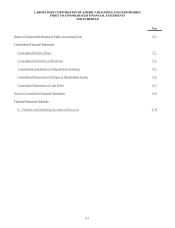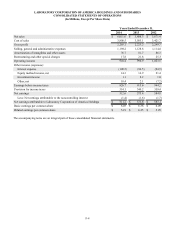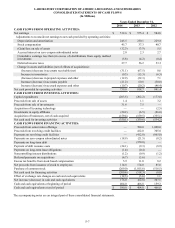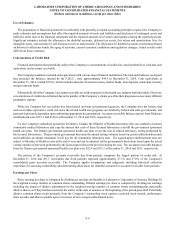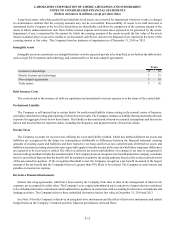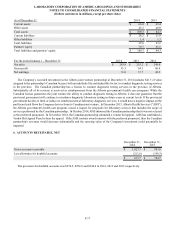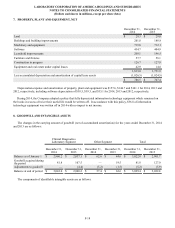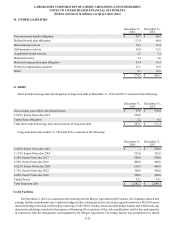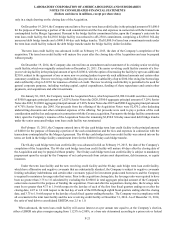LabCorp 2014 Annual Report Download - page 90
Download and view the complete annual report
Please find page 90 of the 2014 LabCorp annual report below. You can navigate through the pages in the report by either clicking on the pages listed below, or by using the keyword search tool below to find specific information within the annual report.
F-11
Years
Buildings and building improvements 10 - 35
Machinery and equipment 3-10
Furniture and fixtures 5-10
Software 3-10
Leasehold improvements and assets held under capital leases are amortized over the shorter of their estimated useful lives or
the term of the related leases. Expenditures for repairs and maintenance are charged to operations as incurred. Retirements, sales
and other disposals of assets are recorded by removing the cost and accumulated depreciation from the related accounts with any
resulting gain or loss reflected in the consolidated statements of operations.
Capitalized Software Costs
The Company capitalizes purchased software which is ready for service and capitalizes software development costs incurred
on significant projects starting from the time that the preliminary project stage is completed and the Company commits to funding
a project until the project is substantially complete and the software is ready for its intended use. Capitalized costs include direct
material and service costs and payroll and payroll-related costs. Research and development costs and other computer software
maintenance costs related to software development are expensed as incurred. Capitalized software costs are amortized using the
straight-line method over the estimated useful life of the underlying system, generally five years.
Long-Lived Assets
The Company assesses goodwill and indefinite lived intangibles for impairment at least annually and more frequently if
triggering events occur. The timing of the Company's annual impairment testing is the end of the fiscal year. In accordance with
the Financial Accounting Standards Board (“FASB”) updates to their authoritative guidance regarding goodwill and indefinite-
lived intangible asset impairment testing, an entity is allowed to first assess qualitative factors as a basis for determining whether
it is necessary to perform quantitative impairment testing. If an entity determines that it is not more likely than not that the estimated
fair value of an asset is less than its carrying value, then no further testing is required. Otherwise, impairment testing must be
performed in accordance with the original accounting standards. The updated FASB guidance also allows an entity to bypass the
qualitative assessment for any reporting unit in its goodwill assessment and proceed directly to performing the first step of the
two-step assessment. Similarly, a Company can proceed directly to a quantitative assessment in the case of impairment testing
for indefinite-lived intangible assets as well. In 2014 and 2013, the Company elected to bypass the purely qualitative assessments
for its goodwill and indefinite-lived intangible assets and proceed to quantitative assessments utilizing methodologies as described
in the following paragraphs.
Step One of the goodwill impairment test includes the estimation of the fair value of each reporting unit as compared to the
book value of the reporting unit. The Company uses a market value approach for determining fair value and utilizes a number of
factors such as publicly available information regarding the market capitalization of the Company as well as operating results,
business plans, and present value techniques. If Step One indicates potential impairment, the second step is performed to measure
the amount of the impairment.
The Company has indefinite-lived assets consisting of acquired Canadian licenses. When a quantitative analysis is considered
necessary for indefinite-lived intangible assets, the Company utilizes an income approach to determine the fair value. It then
compares the carrying value of the indefinite-lived asset to its fair value. Impairment losses are recorded to the extent that the
carrying value of the indefinite-lived intangible asset exceeds its fair value.
There are inherent uncertainties related to the factors described above and judgment related to the Company's impairment
assessments of goodwill and indefinite-lived intangibles. The assumptions underlying the impairment analyses may change in
such a manner that impairment in value may occur in the future. Any such impairment will be recognized in the period in which
it becomes known.
The Company completed an annual impairment analysis of its indefinite lived assets, including goodwill, and has found no
instances of impairment as of December 31, 2014 or 2013.
LABORATORY CORPORATION OF AMERICA HOLDINGS AND SUBSIDIARIES
NOTES TO CONSOLIDATED FINANCIAL STATEMENTS
(Dollars and shares in millions, except per share data)


